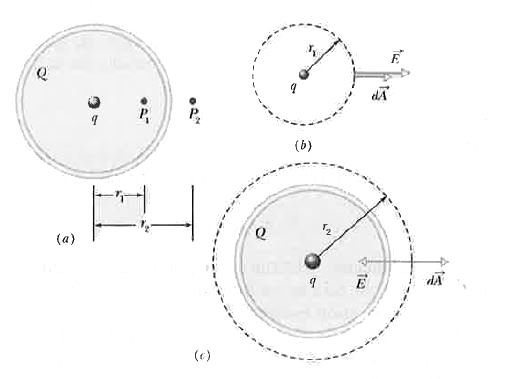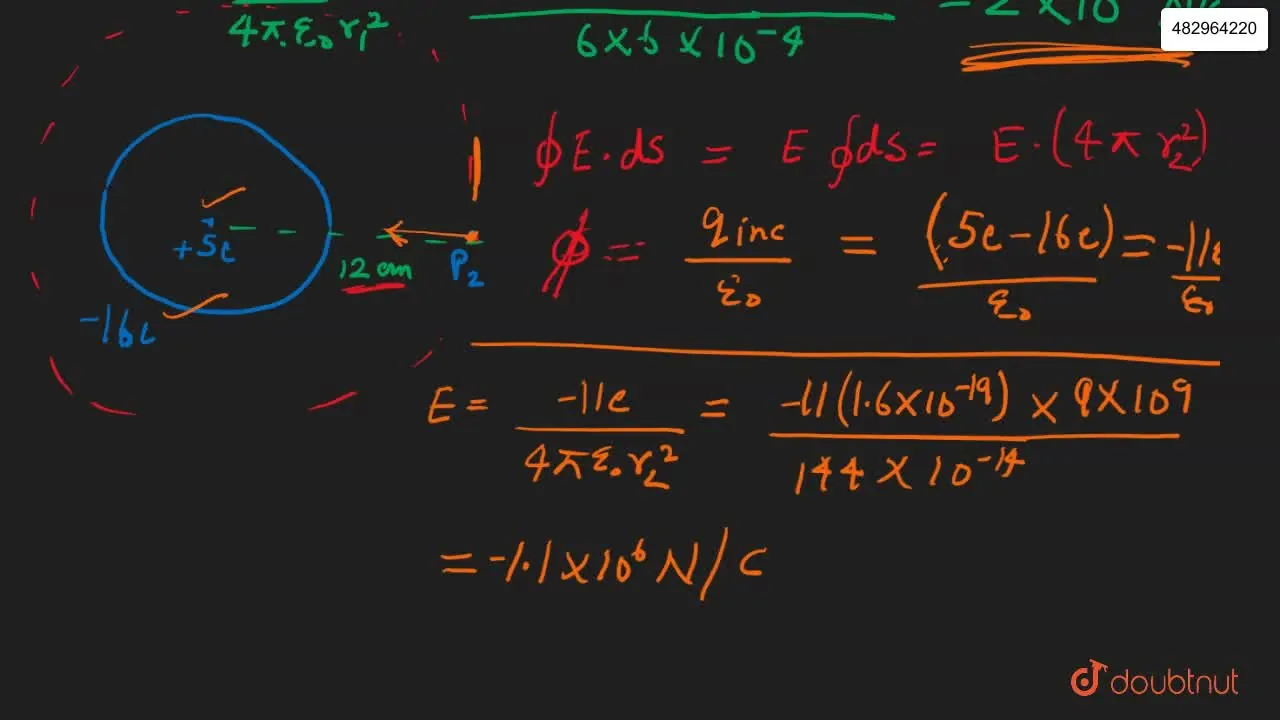shows, in cross section, a plastic, spherical shell with uniform charge and radius A particle with charge is at the center. What is the electric field (magnitude and direction) at (a) point at radial distance and (b) point at radial distance ?
To find the field at point we consturuct a Gaussian sphere with on its surface and thus with a radius of Because the charge enclosed by the Gaussian sphere is positive, the electric flux through the surface must be positive and thus outward. So, the electric field pierces the surface outward and, because of the spherical symmetery, must be radially outward, as drawn in Theat figure does not include the plastic shell because the shell is not enclosed by the Gaussian sphere. Consider a patch element on the sphere at Its area vector is radially outward (it must always be outward from a Gaussian surface). Thus the angle between

(a) A charged plastic spherical shell encloses a charged particle. (b) To find the electric field at arrange for the point to be on a Gaussian aphere. The electric field pierces outward. The area vector for the patch element is out ward. (c ) is on a Gaussian sphere, is inward, and is still outward.
Know that the surface area of a sphere is Substituting these results, for Gauss. law gives us
The only charge enclosed by the Gaussian surface through is that of the particle. Solving for E and substituting we find that the magnitude of the electric field at is
Related Playlists
- BOOK - RESNICK AND HALLIDAYCHAPTER - GAUSS' LAW EXERCISE - CHECKPOINT7videos
GAUSS' LAW
- BOOK - RESNICK AND HALLIDAYCHAPTER - GAUSS' LAW EXERCISE - PROBLEMS42videos
GAUSS' LAW
- BOOK - RESNICK AND HALLIDAYCHAPTER - FORCE AND MOTION-IIEXERCISE - PRACTICE QUESTIONS (Integer Type)1videos
FORCE AND MOTION-II
- BOOK - RESNICK AND HALLIDAYCHAPTER - GEOMETRICAL OPTICS : REFLECTION EXERCISE - PRACTICE QUESTIONS (Integer Type)3videos
GEOMETRICAL OPTICS : REFLECTION
Similar Questions
A spherical shell of radius R1 with uniform charge q is expanded to a radius R2. Find the work performed by the electric forces in this process.
View SolutionA conducting shell of radius R carries charge −Q. A point charge +Q is placed at the centre. The electric field E varies with distance r (from the centre of the shell) as
View SolutionA spherical shell of radius R1 with a uniform charge q has a point charge q0 at its center. Find the work performed by the electric forces during the shell expansion from radius R1 to radius R2.
View SolutionThe electric field intensity at a point located at distance r(r<R) from the center of a spherical conductor (radius R) charged Q will be-
View SolutionA spherical shell of radius R has a charge +q units. The electric field due to the shell at a point
View SolutionThe volume charge density of a sphere carrying charge Q and of radius R is proportional to the square of the distance from the centre. The ratio of the magnitude of the electric field at a distance 2R from the centre to that at a distance of R2 from the centre is
View SolutionA point charge q is placed inside a conducting spherical shell of inner radius 2R and outer radius 3R at a distance of R from the center of the shell. Find the electric potential at the center of the shell.
View SolutionA point charge q produces an electric field of magnitude 2.0NC−1 at a point distant 50 cm from it. From the value of q.
View SolutionA point charge q produces an electric field of magnitude 2NC−1 at a point distance 0.25 m from it. What is the value of charge ?
View SolutionA thin spherical conducting shell of radius R has a charge q. Another charge Q is placed at the centre of the shell. The electrostatic potential at a point P a distance R2 from the centre of the shell is
View Solution


